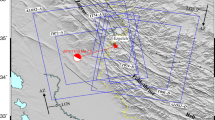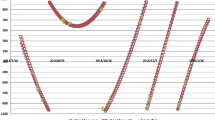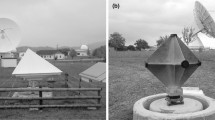Abstract
One-sided ascending or descending Synthetic Aperture Radar (SAR) stereo-radargrammetry has limited accuracy of topographic mapping due to the short spatial baseline (∼100 km) and small intersection angle. In order to improve the performance and reliability of generating digital elevation model (DEM) from spaceborne SAR radargrammetry, an exploration of two-sided stereo-radargrammetry from the combination of ascending and descending orbits with geometric configuration of long spatial baseline (∼1000 km) was conducted in this study. The slant-range geometry between SAR sensors to the earth surface and the Doppler positioning equations were employed to establish the stereoscopic intersection model. The measurement uncertainty of two-sided radargrammetric elevation was estimated on the basis of radar parallax of homogeneous points between input SAR images. Two stereo-pairs of ALOS/PALSAR (Advanced Land Observing Satellite/Phased Array type L-band Synthetic Aperture Radar) acquisitions with the orbital separation almost 1080 km over the west Sichuan foreland basin with rolling topography in southwestern China were employed in the study to obtain the up-to-date terrain data after the 2008 Wenchuan earthquake that hit this area. The quantitative accuracy assessment of two-sided radargrammetric DEM was performed with reference to field GPS observations. The experimental results show that the elevation accuracy reaches 5.5 m without ground control points (GCPs) used, and the accuracy is further improved to 1.5 m with only one GPS GCP used as the least constraint. The theoretical analysis and testing results demonstrate that the two-sided long baseline SAR radargrammetry from the ascending and descending orbits can be a very promising technical alternative for large-area and high accuracy topographic mapping.
Similar content being viewed by others
References
Ahmed R, Siqueira P, Hensley S, et al. (2011) A survey of temporal decorrelation from spaceborne L-Band repeat-pass InSAR. Remote Sensing of Environment 115(11): 2887–2896. DOI: 10.1016/j.rse.2010.03.017
Crosetto M (2002) Calibration and Validation of SAR Interferometry for DEM Generation. ISPRS Journal of Photogrammetry & Remote Sensing 57(3): 213–227. DOI: 10.1016/S0924-2716(02)00107-7.
Chen Q, Liu GX, Ding XL, et al. (2010) Tight integration of GPS observations and persistent scatterer InSAR for detecting vertical ground motion in Hong Kong. International Journal of Applied Earth Observation and Geoinformation 12(6): 477–486. DOI: 10.1016/j.jag.2010.05.002
Ferretti A, Prati C, Rocca F (1999) Multibaseline InSAR DEM reconstruction: The wavelet approach. IEEE Transactions on Geoscience & Remote Sensing 37(2): 705–715. DOI: 10.1109/36.752187.
Hugentobler U, Schaer S, Fridez P (2001) Bernese GPS software, version 4.2. Astronomical Institute, University of Berne. p 515.
Kong YK, Cho BL, Kim YS (2005) Ambiguity-Free Doppler Centroid Estimation Technique for Airborne SAR Using the Radon Transform. IEEE Transactions on Geoscience and Remote Sensing 43(4): 715–721. DOI: 10.1109/TGRS. 2005.843955.
Krieger G, Moreira A, Fiedler H, et al. (2007) TanDEM-X: A Satellite Formation for High Resolution SAR Interferometry. IEEE Transactions on Geoscience & Remote Sensing 45(11): 3317–3341. DOI: 10.1109/TGRS.2007.900693.
Krieger G, Hajnsek I, Papathanassiou KP, et al. (2010) Interferometric Synthetic Aperture Radar (SAR) Missions Employing Formation Flying. Proceedings of the IEEE 98(5): 816–843. DOI:10.1109/JPROC.2009.2038948.
Li ZL, Liu GX, Ding XL (2006) Exploring the Generation of Digital Elevation Models From Same-side ERS SAR Images: Topographic and Temporal Effects. Photogrammetric Record 10(113): 1–17. DOI: 10.1111/j.1477-9730.2006.00356.x.
Liu GX, Li J, Xu Z, et al. (2010) Surface deformation associated with the 2008 Ms8.0 Wenchuan earthquake from ALOS Lband SAR interferometry. International Journal of Applied Earth Observation and Geoinformation 12: 496–505. DOI: 10.1016/j.jag.2010.05.005.
Massonnet D, Rabaute T (1993) Radar Interferometry: Limits and Potential. IEEE Transactions on Geoscience and Remote Sensing 31(2): 455–464. DOI:10.1109/36.214922.
Nahavandchi H (2002) Two different methods of geoidal height determinations using a spherical harmonic representation of the geopotential, topographic corrections and the height anomaly-geoidal height difference. Journal of Geodesy 76: 345–352. DOI:10.1007/s00190-002-0253-x.
Raggam H, Perko R, Gutjahr K (2009) Investigation of the Stereo-Radargrammetric Mapping Potential of TerraSAR-X. Proceeding of the 29th EARSeL Symposium, Chania, Greece: 371–380. DOI: 10.3233/978-1-60750-494-8-371.
Raggam H, Gutjahr K, Perko R, et al. (2010) Assessment of the Stereo-Radargrammetric Mapping Potential of TerraSAR-X Multibeam Spotlight Data. IEEE Transactions on Geoscience and Remote Sensing 48(2): 971–977. DOI: 10.1109/TGRS. 2009.2037315.
Raucoules D, Ristori B, Michele MD, et al. (2010) Surface displacement of the Mw 7 Machaze earthquake (Mozambique): Complementary use of multiband InSAR and radar amplitude image correlation with elastic modeling, Remote Sensing of Environment 114(10): 2211–2218. DOI: 10.1016/j.rse.2010. 04.023.
Renga A, Moccia A (2009) Performance of Stereoradargrammetric Methods Applied to Spaceborne Monostatic-Bistatic Synthetic Aperture Radar. IEEE Transactions on Geoscience and Remote Sensing 41(2): 544–560. DOI:10.1109/TGRS.2008.2003184.
Sansosti E (2004) A simple and exact solution for the interferometric and stereo SAR geolocation problem. IEEE transactions on Geoscience and Remote Sensing 42(8): 1625–1634. DOI:10.1109/TGRS.2004.831442.
Schanda E (1985) A radargrammetry experiment in a mountain region. International Journal of Remote Sensing 6(7): 1113–1124. DOI: 10.1080/01431168508948266.
Li WL, Huang RQ, Tang C, et al. (2013) Co-seismic landslide inventory and susceptibility mapping in the 2008 Wenchuan earthquake disaster area, China. Journal of Mountain Science 10(3): 339–354. DOI: 10.1007/s11629-013-2471-5.
Toutin T (1996) Opposite side ERS-1 SAR Stereo Mapping over Rolling Topography. IEEE Transactions on Geoscience and Remote Sensing 34(2): 543–549. DOI: 10.1109/36.485130.
Toutin T, Gray L (2000) State-of-the-art Elevation Extraction from Satellite SAR Data. ISPRS Journal of Photogrammetry and Remote Sensing 55(1): 13–33. DOI: 10.1016/S0924-2716(99)00039-8.
Toutin T (2002) Impact of Terrain Slope and Aspect on Radargrammetric DEM Accuracy. ISPRS Journal of Photogrammetry & Remote Sensing 38(2): 782–789. DOI: 10.1016/S0924-2716(02)00123-5.
Yan ZX, Ma GZ, Yuan BX, et al. (2012) The Origin of the 2008 Wenchuan Earthquake Determined by the Analysis on the Active Longmenshan Nappe in Terms of Rockmass Mechanics. Journal of Mountain Science 9: 395–402. DOI: 10.1007/s11629-009-2256-z.
Yu JH, Li XJ, Ge LL (2011) Radargrammetric DEM generation using ENVISAT simulation image and reprocessed image. IEEE International Symposium on Geoscience and Remote Sensing (IGARSS2011). DOI: 10.1109/IGARSS.2011.6049842: 2980-2983.
Zebker HA, Goldstein RM (1986) Topographic Mapping from Interferometric SAR Observations. Journal of Geophysical Research 91(5): 4993–4999. DOI: 10.1029/JB091iB05p04993.
Zhang L, Ding XL, Lu Z (2011) Ground settlement monitoring based on temporarily coherent points between two SAR acquisitions. ISPRS Journal of Photogrammetry and Remote Sensing 66: 146–152. DOI: 10.1016/j.isprsjprs.2010.10.004.
Zhao CY, Lu Z, Zhang Q, et al. (2012) Large-area landslide detection and monitoring with ALOS/PALSAR imagery data over Northern California and Southern Oregon, USA. Remote Sensing of Environment 124: 348–359. DOI: 10.1029/2002JB002267.
Author information
Authors and Affiliations
Corresponding author
Rights and permissions
About this article
Cite this article
Cheng, Hq., Chen, Q., Liu, Gx. et al. Two-sided long baseline radargrammetry from ascending-descending orbits with application to mapping post-seismic topography in the west Sichuan foreland basin. J. Mt. Sci. 11, 1298–1307 (2014). https://doi.org/10.1007/s11629-013-2826-y
Received:
Accepted:
Published:
Issue Date:
DOI: https://doi.org/10.1007/s11629-013-2826-y




